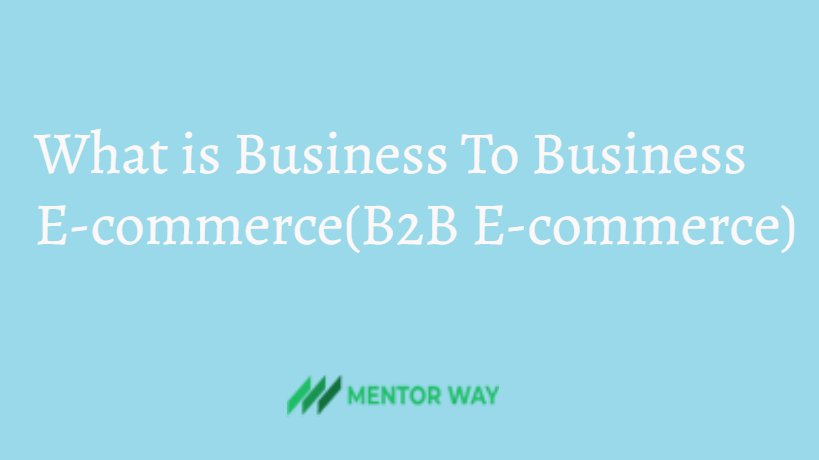What is Business To Business E-commerce(B2B E-commerce)

B2B E-commerce: Business-to-business (B2B) e-commerce is the largest form of e-commerce. It is the e-commerce between two organizations. It is also known as e-business and is experiencing an explosive growth rate on the internet. Companies are now mutually buying and selling products and services on the internet.
B2B e-commerce is more than a mechanism for taking orders online. B2B e-commerce is a network of independent organizations involved in a business area or an industry.
It is also a new way to view products, production and pricing. It is delivering customized services and goods, and managing inventory for business partners. With B2B e-commerce, supply-chain participants are directly connected.
B2B offers unique benefits such as less human intervention, less overhead expenses, fewer error, more efficiency, more advertising exposure, new markets. It is a win-win situation for both buyer and seller.
There are two primary components of B2B market: E-infrastructure and E-markets. E-marketplace is an online electronic market where buyers and sellers meet to exchange goods, services, money or information.
E-infrastructure is the architecture of B2B which primarily consists of logistics, application service providers consists of logistics, application service providers, outsourcing of functions in the process of e-commerce etc.
Features of Business-to-Business E-commerce:-
Following are the features of B2B e-commerce:-
- In B2B e-commerce, one business uses a web browser to interact with a web server application of another business.
- The relationship focuses on online procurement, order-fulfillment, and work-in-progress tracking for high-volume transactions.
- With B2B e-commerce, supply-chain participations are directly connected.
- Multiple forms of electronic payment and other payment methods are permitted. Several banking instruments and internet payment schemes are permitted.
- There are prior agreements or contracts between the partners involved in the B2B e-commerce.
- A much higher level of information exchange between the different trading partners is involved in the Business-to-business e-commerce business cycle.
- There are multiple levels of authorization of purchases, each level having its own limits on expenditure on various types of goods.
- It involves different type of taxation regimes depending on where the two parties are from and what type of goods are being transacted.
Advantages of Business-to-Business E-commerce:-
Following are the advantages of Business-to-business e-commerce:-
- Managing inventory more efficiently.
- Adjusting more quickly to customer demand.
- Getting products to market faster.
- Cutting lower prices on some supplies.
- Lesser human intervention.
- Reduction overhead expenses.
- Reduction in errors.
- Increased efficiency.
- More advertising exposure.
Building Blocks\Key Components of B2B E-commerce:-
Following are the Building blocks\Key components B2B e-commerce:-
-
Application Server:-
Application server is required to develop, manage and execute B2B services and traffic for higher performance and non-stop service. It manages connections and applications, makes services available during upgrades, monitors security, detects dead connections and endures a fault-tolerant B2B environment.
-
B2B Integration Server:-
An integration server is required to join company, external and application data or documents for quick, secure and reliable service. It is necessary that a large number of systems and protocols must work together to support B2B e-commerce.
-
Personalization Software:-
The personalization software makes it possible for a company with multiple buyers (partners) to display or provide only the content that is unique to the partner. It takes into consideration factors like stored partner profile, purchasing behavior and user-privileges. Its goal is to provide a tightly focused B2B interface and interaction with each partner.
-
Content Management Facility:-
Content management facility is required to ensure that the content reaches the designated user or online system. It is essential in order to serve the content to the appropriate user.
-
E-commerce Packages:-
E-commerce packages is a set of programs which includes customer service and product management, a storefront for direct delivery, a shopping cart and order-fulfillment modules.



